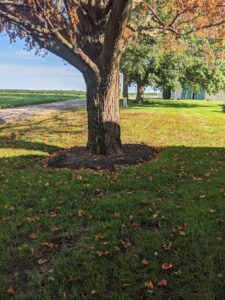Fall has arrived! The beautiful foliage that we love to admire this time of year will soon become the yearly chore of managing fallen leaves. You have likely heard the adage “leave the leaves” many times by now. This practice is gaining traction along with many other pollinator-friendly landscape management tactics, such as saving dead stems or “No Mow May”. Many benefits come from leaving fallen leaves in place, including improved soil health and protection for overwintering insects like pollinators and fireflies. But what does the research actually say about leaving the leaves? Does it work, and can it make a difference?
The short answer is: yes!
In the United States, yards are estimated to cover approximately 2.3 million km2 across urban, suburban, and rural residential lands (Lerman et al. 2023). To put this in perspective, there is approximately 1.2 million km2 of protected land in the US (UNEP-WCMC 2025). That means yards occupy almost double the amount of land as protected parks and preserves in the US! While a suburban landscape may not be able to offer all the same ecosystem services as a state forest, there is still enormous potential for residential areas to make meaningful contributions to biodiversity conservation efforts.
Back to the leaves – what difference does a yard make to the insect community? Research from Ferlauto and Burghardt (2025) in Maryland found that leaf removal was detrimental to many groups of arthropods, including Coleoptera (beetles), Lepidoptera (butterflies and moths), and spiders. Removal of leaf litter resulted in a 45% reduction in Lepidoptera spring emergence and a 40% decline in species richness compared to yards where leaves were left in place. Removing leaves also reduced spider abundance by 67% and beetle abundance by 24%.
Retaining fallen leaves is beneficial to arthropod diversity and richness, and the research backs this up. However, protecting turf is a priority for many homeowners and landscapers. Heavy leaf fall which completely covers the ground will smother the turf, so removing leaves is necessary in these situations. Consider preserving some of the leaf fall as mulch around trees and landscape plants, or keep only a sparse coverage of leaves on the ground. Even a small amount of leaf retention will make a difference to the sleeping arthropods.
References
Ferlauto and Burghardt (2025). Removing autumn leaves in residential yards reduces the spring emergence of overwintering insects. Science of The Total Environment, 970: 178821. doi.org/10.1016/j.scitotenv.2025.178821
Lerman et al. (2023). Humanity for Habitat: Residential Yards as an Opportunity for Biodiversity Conservation. BioScience, 73:9, 671–689. doi.org/10.1093/biosci/biad085
UNEP-WCMC (2025). Protected Area Profile for United States of America from the World Database on Protected Areas, October 2025. Available at: protectedplanet.net
